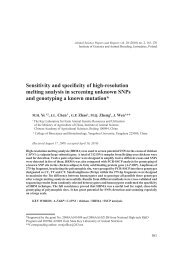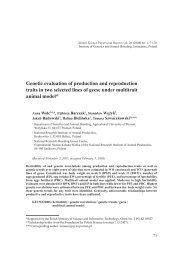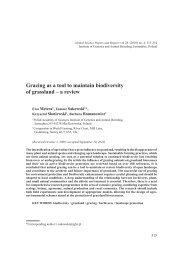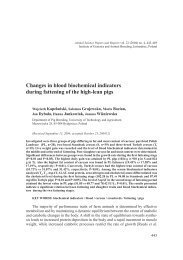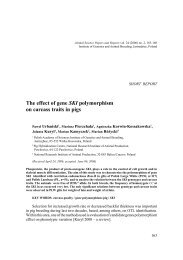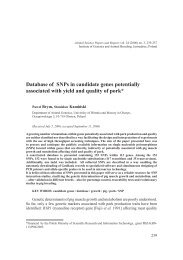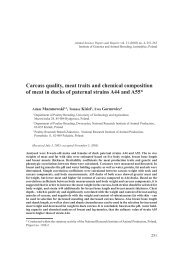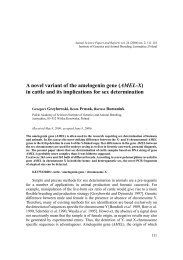Hoof size as related to body size in the horse (Equus caballus)
Hoof size as related to body size in the horse (Equus caballus)
Hoof size as related to body size in the horse (Equus caballus)
Create successful ePaper yourself
Turn your PDF publications into a flip-book with our unique Google optimized e-Paper software.
<strong>Hoof</strong> <strong>size</strong> <strong>as</strong> <strong>related</strong> <strong>to</strong> <strong>body</strong> <strong>size</strong> <strong>in</strong> <strong>the</strong> <strong>horse</strong><br />
hence it may be expected that <strong>in</strong> males <strong>the</strong> ratios approximate those of females. For<br />
<strong>the</strong> advantages of big hooves <strong>in</strong> <strong>horse</strong>s it is suggested <strong>to</strong> consider <strong>the</strong> hooves <strong>as</strong> big<br />
and favourable if <strong>the</strong> ratio exceeds <strong>the</strong> mean. S<strong>in</strong>ce <strong>the</strong> dimensions constitut<strong>in</strong>g <strong>the</strong><br />
ratio are e<strong>as</strong>y <strong>to</strong> me<strong>as</strong>ure, <strong>the</strong> ratio may be commonly used <strong>in</strong> estimat<strong>in</strong>g <strong>the</strong> <strong>horse</strong>’s<br />
conformation.<br />
Ano<strong>the</strong>r less variable ratio w<strong>as</strong> <strong>the</strong> <strong>to</strong>e length <strong>to</strong> chest circumference. Solely PA<br />
mares differed from those of o<strong>the</strong>r breeds, hav<strong>in</strong>g relatively shorter <strong>to</strong>es and bigger<br />
chest circumference. However, <strong>the</strong> correlations with <strong>the</strong> <strong>to</strong>e length were lower than<br />
with <strong>the</strong> hoof width (Tab. 3), hence this ratio seems <strong>to</strong> be less applicable <strong>to</strong> me<strong>as</strong>ure<br />
<strong>the</strong> relative hoof <strong>size</strong>.<br />
To conclude, <strong>the</strong> results of this study show that <strong>the</strong> hoof width <strong>to</strong> chest circumference<br />
ratio is a suitable parameter of <strong>the</strong> hoof <strong>size</strong>. The hoof <strong>to</strong> <strong>body</strong> dimension ratios grow<br />
along with <strong>the</strong> <strong>in</strong>cre<strong>as</strong><strong>in</strong>g ratio of cannon circumference <strong>to</strong> height at wi<strong>the</strong>rs. The age<br />
hardly affects <strong>the</strong> hoof solar <strong>size</strong> <strong>to</strong> height at wi<strong>the</strong>rs ratio <strong>in</strong> <strong>horse</strong>s s<strong>in</strong>ce four <strong>to</strong> n<strong>in</strong>e<br />
years old.<br />
REFERENCES<br />
1. BACK W., SCHAMHARDT H.C., HARTMAN W., BARNEVELD A., 1995 – K<strong>in</strong>ematic differences<br />
between <strong>the</strong> distal portions of <strong>the</strong> forelimbs and h<strong>in</strong>dlimbs of <strong>horse</strong>s at <strong>the</strong> trot. American Journal of<br />
Veter<strong>in</strong>ary Research 56 (11), 1522-1528.<br />
2. BALCH O., CLAYTON H., LANOVAZ J., 1994 – Effects of <strong>in</strong>cre<strong>as</strong><strong>in</strong>g hoof length on limb<br />
k<strong>in</strong>ematics of trott<strong>in</strong>g <strong>horse</strong>s. Proceed<strong>in</strong>gs of Annual Convention of <strong>the</strong> American Association of<br />
Equ<strong>in</strong>e Practitioners 40, 43.<br />
3. BUTLER D., 1995 – The Pr<strong>in</strong>ciples of Horseshoe<strong>in</strong>g II. Butler Publish<strong>in</strong>g, LaPorte.<br />
4. BUTLER K.D., HINTZ H.F., 1977 – Effect of level of <strong>in</strong>take and gelat<strong>in</strong> supplementation on growth<br />
and quality of hoofs of ponies. Journal of Animal Science 44, 257-261.<br />
5. CLAYTON H.M., 1977 – Effect of added weight on land<strong>in</strong>g k<strong>in</strong>ematics of jump<strong>in</strong>g <strong>horse</strong>s. Equ<strong>in</strong>e<br />
Veter<strong>in</strong>ary Journal 23 (Supplement.), 50-53.<br />
6. CLAYTON H.M., LANOVAZ J.I., SCHAMHARDT H.C., WESSUM R. VAN, 1999 – Rider<br />
effects on ground reaction forces and fetlock k<strong>in</strong>ematics at <strong>the</strong> trot. Equ<strong>in</strong>e Veter<strong>in</strong>ary Journal 30<br />
(Supplement), 235-239.<br />
7. DUCRO B.J., BOVENHUIS H., BACK W., 2009a – Heritability of foot conformation and its<br />
relationship <strong>to</strong> sport performance <strong>in</strong> a Dutch Warmblood <strong>horse</strong> population. Equ<strong>in</strong>e Veter<strong>in</strong>ary<br />
Journal 41 (2), 139-143.<br />
8. DUCRO B.J., GORISSEN B., ELDIK P. VAN, BACK W., 2009b – Influence of foot conformation<br />
on duration of competitive life <strong>in</strong> a Dutch Warmblood <strong>horse</strong> population. Equ<strong>in</strong>e Veter<strong>in</strong>ary Journal<br />
41 (2), 144-148.<br />
9. GUSTAS ° P., JOHNSTON C., ROEPSTORFF L., DREVEMO S., LANSHAMMAR H., 2004 –<br />
Relationships between fore- and h<strong>in</strong>dlimb ground reaction force and hoof deceleration patterns <strong>in</strong><br />
trott<strong>in</strong>g <strong>horse</strong>s. Equ<strong>in</strong>e Veter<strong>in</strong>ary Journal 36 (8), 737-742.<br />
10. HEEL M.C.V. VAN, DIERENDONCK M.C. VAN, KROEKENSTOEL A.M., BACK W., 2010 –<br />
Lateralised mo<strong>to</strong>r behaviour leads <strong>to</strong> <strong>in</strong>cre<strong>as</strong>ed unevenness <strong>in</strong> front feet and <strong>as</strong>ymmetry <strong>in</strong> athletic<br />
performance <strong>in</strong> young mature Warmblood <strong>horse</strong>s. Equ<strong>in</strong>e Veter<strong>in</strong>ary Journal 42 (5), 444-450.<br />
11. KUMMER M., GEYER H., IMBODEN I., AUER J., LISCHER C., 2006 – The effect of hoof<br />
trimm<strong>in</strong>g on radiographic me<strong>as</strong>urements of <strong>the</strong> front feet of normal Warmblood <strong>horse</strong>s. The<br />
Veter<strong>in</strong>ary Journal 172 (1), 58-66.<br />
221



